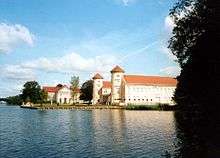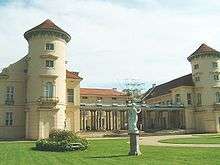Rheinsberg Palace

Rheinsberg Palace (German: Schloss Rheinsberg) lies in the municipality of Rheinsberg, about 100 kilometres northwest of Berlin in the German district of Ostprignitz-Ruppin.
The palace on the eastern shore of the Grienericksee is a classic example of the so-called Frederician Rococo architecture style and served as a basis for Sanssouci Palace.
History


In the Middle Ages a moated castle stood on the site of Rheinsberg Palace. The von Bredow family had acquired the lordship of Rheinsberg through marriage in 1464 from the von Platen and had a water castle built on this spot in 1566 in Renaissance style. However, it was badly damaged during the Thirty Years' War and, in 1618, was sold to Kuno von Lochow. When his line died out, the castle went to Prince-Elector Frederick William, who gifted it to his General, Franz du Hamel. With the permission of the elector, he sold it however to Benjamin Chevenix de Beville, who alienated it in March 1734 for 75,000 thalers to the Prussian king, Frederick William I. Frederick William in turn gave it to his son, Crown Prince Frederick, later King Frederick the Great for his loyalty. In 1736 he moved with his wife, Princess Elisabeth Christine to the southern wing of the castle. In the years up to 1740 Frederick had the castle considerably extended and improved by the architects Johann Gottfried Kemmeter and Georg Wenzeslaus von Knobelsdorff, who learned his architectural craft, so to speak, from Kemmeter. Thus, an upper floor was added to the single-storey building and the East Wing extended by 25 metres.
Frederick himself always described his years at Rheinsberg Palace as the "happiest of his life". His time in Rheinsberg ended in 1740 with his accession to the throne.

Four years later he gave it to his younger brother Henry, who moved there in 1752 with his wife, Princess Wilhelmina of Hesse-Kassel. The king also had a grand palace built for him in Berlin between 1748 and 1753 which now houses the main building of Humboldt University. The art-loving prince went on to extend and embellish the castle and its adjoining park. In 1786, Georg Friedrich von Boumann and Carl Gotthard Langhans completed the palace to its original plans. Langhans had stayed in Rheinsberg for a few weeks in 1766, and had made plans for Prince Henry, which were implemented in subsequent years by his building director, Carl Wilhelm Hennert. In 1785/86, Bouman built the two pavilions at the castle, which Langhans probably tore down. During Henry's lifetime, Henry had his tomb built in the garden in the form of a truncated pyramid, where he was buried after his death in 1802. He even wrote the French inscription himself.
The palace rose to literary fame when it was described by Theodor Fontane in his book Wanderungen durch die Mark Brandenburg ("Walks through the March of Brandenburg") and by Kurt Tucholsky in his Rheinsberg. Ein Bilderbuch für Verliebte ("Rheinsberg. A Picture Book for Those in Love"). Until expropriation in 1945, Rheinsberg Palace was owned by the House of Hohenzollern.
During East German times, the palace housed a diabetes clinic. Today the palace and its gardens belong to the Berlin-Brandenburg Foundation for Prussian Palaces and Gardens. After lengthy and extensive restoration, the palace is now a museum and home to the Kurt Tucholsky Literature Museum. Since 1991, the Federal and State Academy of Music has been accommodated in the former Cavalier House (Kavaliershaus), and runs the palace theatre. Also since 1991 the International Opera Festival has taken place in the palace theatre, the courtyard and the open-air theatre (Heckentheater).
External links
| Wikimedia Commons has media related to Schloss Rheinsberg. |
- Berlin-Brandenburg Foundation for Prussian Palaces and Gardens
- Rheinsberg Chamber Opera
- Kurt Tucholsky Literaturmuseum
- Interaktive Panorama photography of Rheinsberg Palace
- Material on Rheinsberg Palace in the Duncker Collection at the Berlin Central and State Library (pdf; 283kB)
Literature
- Theodor Fontane: Wanderungen durch die Mark Brandenburg, Vol. 1 (County of Ruppin) "Rheinsberg"
- Andrew Hamilton: Rheinsberg. Das Schloß, der Park, Kronprinz Friedrich und Bruder Heinrich. Selected and edited by Franz Fabian. Based on a translation from English by Rudolf Dielitz (first published in London in 1872), Aufbau Verlag, Berlin 1992, ISBN 3-351-02111-9
- Ludwig Sternaux: Mein kleines Sanssouci. Schloß Rheinsberg und seine Erinnerungen, Hahn's Erben, Berlin 1936
- Generaldirektion der Staatlichen Schlösser und Gärten Potsdam-Sanssouci (Hrsg.): Rheinsberg : Eine märkische Residenz des 18. Jahrhunderts. Ausstellung vom 21. - 29. Juni 1985 im Schloss Rheinsberg (= Katalog der Ausstellung zur 650-Jahrfeier der Stadt Rheinsberg 1985, Gestaltung: Herbert Sander), Generaldirektion der Staatlichen Schlösser und Gärten Potsdam-Sanssouci, Potsdam 1990
- Christian von Krockow: Rheinsberg. Ein preußischer Traum, E. A. Seemann, Leipzig 1992, ISBN 3-363-00554-7
- Stiftung Preußische Schlösser und Gärten Berlin-Brandenburg (Hrsg.): Schloß Rheinsberg. Amtlicher Führer der Stiftung Schlösser und Gärten Potsdam-Sanssouci, Stiftung Preußische Schlösser und Gärten Berlin-Brandenburg, Potsdam 1993
Coordinates: 53°5′55″N 12°53′22″E / 53.09861°N 12.88944°E